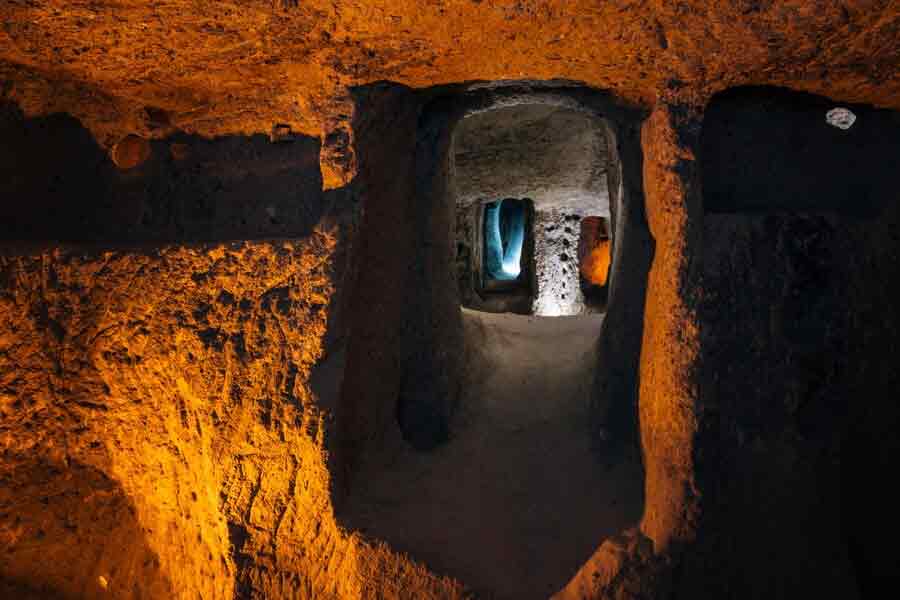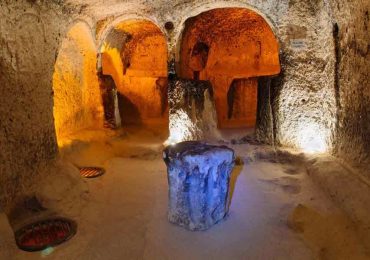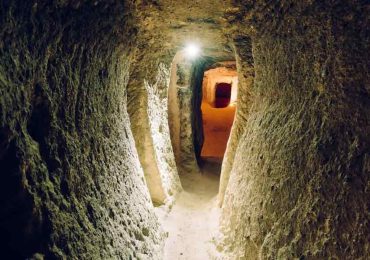
Exploring the Underground Cities of Cappadocia
Cappadocia is a fascinating journey through times gone by – but ultimately the major attraction to this Central Anatolia moonscape are the underground cities. Beneath the land of the living, are masses of sprawling tunnels and small cave rooms that are strangely quiet but their history is as the saving grace for civilizations that hid in fear of their lives.
About 35 underground cities stretch across the vast landscapes of Cappadocia, but new ones are being discovered all the time. Built with the intention of being hiding places for early citizens who could at any new day, find their way of life under threat from invading forces, they have also been the subject of conspiracy theories as certain parties debate whether they were built by aliens.
Derinkuyu Underground City
One of the most famous underground cities in Cappadocia is Derinkuyu, built during the Byzantine era, when its inhabitants used it to protect themselves from Muslim Arabs during the Arab-Byzantine wars between 780 and 1180 CE. The multi-level city was composed of many passages and caves lying at around 60m (197ft) under the ground and was able to shelter around 20,000 people as well as their livestock and food. It’s certainly the deepest underground city in Cappadocia (and in all of Turkey). Derinkuyu was opened to visitors in 1969 – albeit, with only half of the city available for viewing.
History of Derinkuyu Underground City
The exact construction date of this amazing human made underground city and cave networks are not known. Nevertheless, archaeologist states that use of Derinkuyu underground city goes back to the Hittites 1900-1200 BC during the bronze age. First of all, early Christians took the advantages of using them, not only to hide from enemies but also to keep their stocks safe and store their food in fresh. Secondly, Turkish villagers hide in these places during the devastating Mongol’s invasion in 13 century and also during the First World War in 1914 to 1918. Consequently, in the course of time and history people used the underground city for the same purpose, to protect their life and food from invaders and enemies.
Function and Use of Derinkuyu Underground City
The entire underground city was carved in to the soft volcanic material, called ignimbrite. Ignimbrite is a pumice-dominated pyroclastic flow deposit formed from the cooling of pyroclastic material ejected from an explosive volcanic eruption. This material is quite soft and it is easy to chisel. Over the centuries people dug down eight stories, approximately eighty meter below the surface until they reach the underground water. They also extended the underground city couple of kilometers wide to accommodate up to thirty thousand people at the same time.
Kaymakli Underground City
Kaymakli Underground City is the biggest and deepest underground settlement in the Cappadocia region. Located in the Kaymaki Village, Kaymakli Underground City is also one most popular places to see in Cappadocia.
What’s Inside?
Kaymakli Underground City has 8 levels underground (only 4 are open) carved from the soft volcanic stone that are connected with each other by narrow tunnels. Visitors may visit stalls, stables, stores, refectories, churches, wineries, kitchens and the other sections.
Going for 40 meters under the ground, Kaymakli Underground City has a capacity of 5000 people. It is very exciting to imagine that how people lived here. A visit to Kaymakli Underground City is a must on your Cappadocia holidays.
Function and Use of Kaymakli Underground City
The entire underground city was carved in to the soft volcanic material, called ignimbrite. Ignimbrite is a pumice-dominated pyroclastic flow deposit formed from the cooling of pyroclastic material ejected from an explosive volcanic eruption. This material is quite soft and it is easy to chisel. Over the centuries people dug down eight stories, approximately eighty meter below the surface until they reach the underground water. They also extended the underground city couple of kilometers wide to accommodate up to thirty thousand people at the same time.


